
This word problem task involves ratios.
- Subject:
- Mathematics
- Material Type:
- Activity/Lab
- Provider:
- Illustrative Mathematics
- Provider Set:
- Illustrative Mathematics
- Author:
- Illustrative Mathematics
- Date Added:
- 05/01/2012

This word problem task involves ratios.
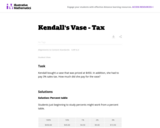
This word problem requires students to compute sales tax.

In this video [2:25] you will meet experts who operate a bank in their school. The tellers, bookkeepers and board members are all kids, but kids and grownups can make deposits into real accounts. Banks are a great place to keep and save money!

It all about money! Explore the concept of money in this real-world, unit plan. A collection of six lessons where students practice skills such as coin identification, mental math, menu math, making change, math operations with coins, and more. Thoroughly written, packed with engaging activities, and complete with printable worksheets. A Canadian money lesson that can be easily adapted for U.S. coins.

This activity is designed to teach the attributes of each coin (penny, nickel, dime and quarter), including physical characteristics and value.
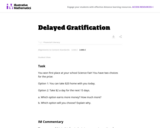
The purpose of this task is for students to compare two options for a prize where the value of one is given $2 at a time, giving them an opportunity to "work with equal groups of objects to gain foundations for multiplication." This context also provides students with an introduction to the concept of delayed gratification, or resisting an immediate reward and waiting for a later reward, while working with money.

The purpose of this task is to generate a classroom discussion about ratios and unit rates in context.

Personal and business services from MasterCard, a leader in American industry and finance.

In this lesson, students will create and solve word problems involving money (addition, subtraction, multiplication, and division of decimals), and develop a script for a short scene and perform it using the elements of performance. Media resources and teacher materials are included.
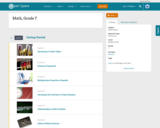

Proportional Relationships
Type of Unit: Concept
Prior Knowledge
Students should be able to:
Understand what a rate and ratio are.
Make a ratio table.
Make a graph using values from a ratio table.
Lesson Flow
Students start the unit by predicting what will happen in certain situations. They intuitively discover they can predict the situations that are proportional and might have a hard time predicting the ones that are not. In Lessons 2–4, students use the same three situations to explore proportional relationships. Two of the relationships are proportional and one is not. They look at these situations in tables, equations, and graphs. After Lesson 4, students realize a proportional relationship is represented on a graph as a straight line that passes through the origin. In Lesson 5, they look at straight lines that do not represent a proportional relationship. Lesson 6 focuses on the idea of how a proportion that they solved in sixth grade relates to a proportional relationship. They follow that by looking at rates expressed as fractions, finding the unit rate (the constant of proportionality), and then using the constant of proportionality to solve a problem. In Lesson 8, students fine-tune their definition of proportional relationship by looking at situations and determining if they represent proportional relationships and justifying their reasoning. They then apply what they have learned to a situation about flags and stars and extend that thinking to comparing two prices—examining the equations and the graphs. The Putting It Together lesson has them solve two problems and then critique other student work.
Gallery 1 provides students with additional proportional relationship problems.
The second part of the unit works with percents. First, percents are tied to proportional relationships, and then students examine percent situations as formulas, graphs, and tables. They then move to a new context—salary increase—and see the similarities with sales taxes. Next, students explore percent decrease, and then they analyze inaccurate statements involving percents, explaining why the statements are incorrect. Students end this sequence of lessons with a formative assessment that focuses on percent increase and percent decrease and ties it to decimals.
Students have ample opportunities to check, deepen, and apply their understanding of proportional relationships, including percents, with the selection of problems in Gallery 2.

In Part l of this two-part lesson, students use an interactive to place percent increase and percent decrease signs between monetary amounts to indicate the correct increase or decrease between the amounts of money. They must also place the correct decimal multiplier between the two amounts to show what decimal to multiply the original amount by to get the final amount.Key ConceptsStudents apply understanding of percent change situations to systematize and generalize patterns in relating two amounts by multiplication.Goals and Learning ObjectivesIdentify the percent increase or percent decrease between two amounts.Identify the decimal multiplier that when multiplied by the original amount results in the final amount.Reason abstractly and quantitatively.

In this short overview of the Federal Reserve System, students will get acquainted with the major roles and responsibilities of the central bank. It is a module that is designed primarily for those who are preparing a trip to the Federal Reserve Bank of Chicago (or another regional Federal Reserve location). It could also serve as a primer for students just being introduced to the Fed in various contexts.

Students will become more comfortable making sense of equations presented in missing answer (traditional) and missing number ( nontraditional) formats.
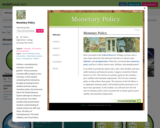
Inflation, unemployment, recession, economic growth?these economic concepts affect people in very real ways. In this module containing three interactive, thought-provoking lessons, students will learn about monetary policy, the avenue by which the Federal Reserve System attempts to influence the economy. Four other modules that would further students understanding of related content are GDP and Pizza, The Story of Unemployment, The Great Inflation, and Fiscal Policy.

Video writing prompt asks, do you ever feel like you are throwing money away? Why or why not? [0:38]

Download these free worksheets to sharpen your money skills. Sheets focus on adding and subtracting money, counting coins, dollars, making change, and multiplying and dividing money.
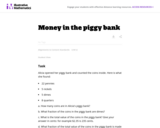
This task is designed to help students focus on the whole that a fraction refers to. It helps students to realize that two different fractions can describe the same situation depending on what you choose to be the whole.

The purpose of this task is for students to solve problems involving decimals in a context involving a concept that supports financial literacy, namely inflation.

This short video and interactive assessment activity is designed to teach fourth graders about multi-step money problems.